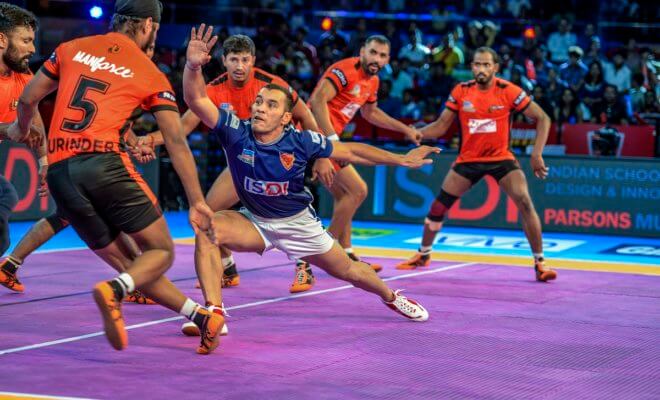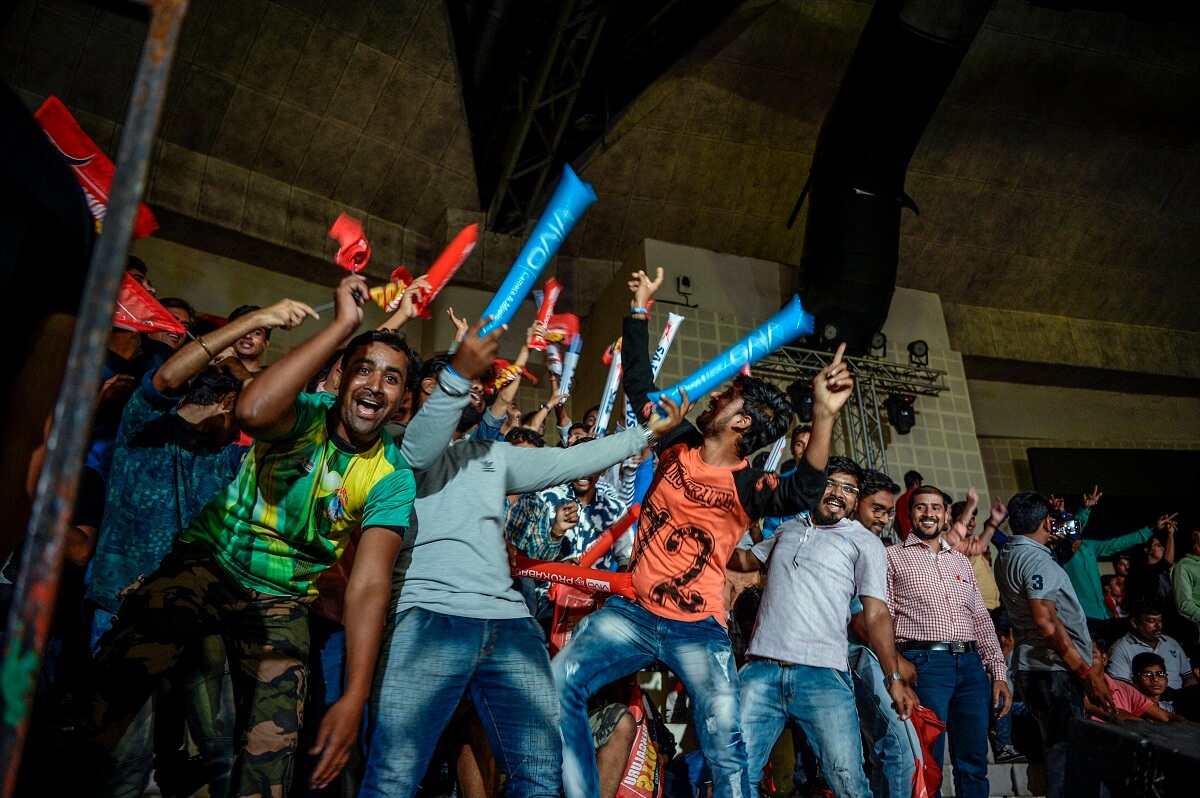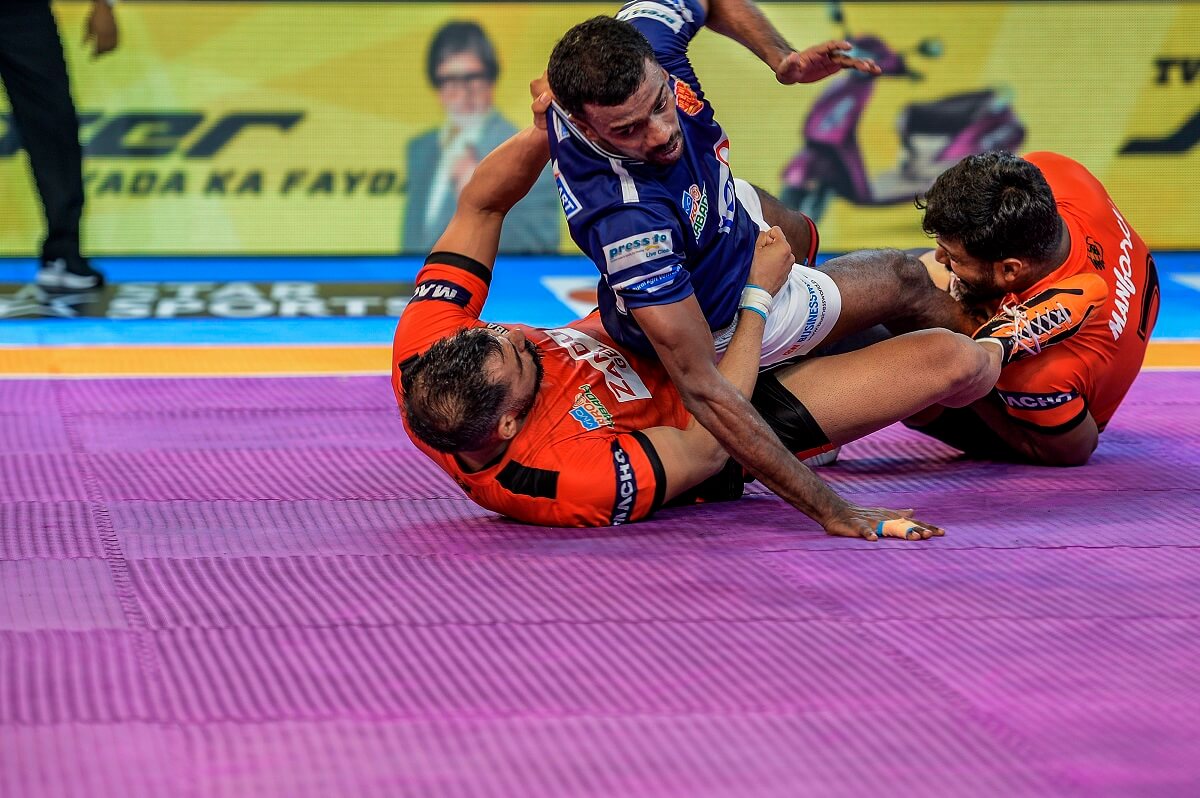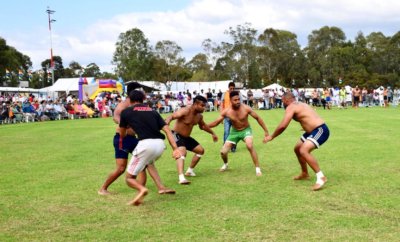Life
Rugby Meets Red Rover: Kabaddi Has Captured the Heart of India

Kabaddi players during a match in Nagpur, India, Aug. 5, 2017.
Photo: Atul Loke/The New York Times
Given kabaddi’s recent gains, it should continue to penetrate the Indian market and may eventually even garner attention in the West.
For the uninitiated, kabaddi, the ancient Indian game that is taking the world’s second-most populous country by storm, looks far too simple to be a professional sport.
A hybrid of rugby, touch football and the playground game known in England as British Bulldog and in the United States as Red Rover (“Red rover, red rover, let Tommy come over…”), kabaddi (pronounced kuh-bud-DEE) uses no balls, pucks, nets, goal posts, hoops, holes, rackets, clubs, sticks or bats. It is so unknown in the West that on Aug. 8, 2017, ESPNU, the American digital cable and satellite sports television channel owned by ESPN Inc., showcased what it termed “the finest in seldom-seen sports,” including the 2016 Kabaddi World Cup Final. An exhibition match was played at the 1936 Olympics in Berlin, but it did not catch on internationally.
But those who take the time to examine India’s rare homegrown game that is gaining appeal abroad begin to recognize a highly strategic endeavor that demands speed, strength, timing, an understanding of geometric angles and the kind of fancy footwork that would have impressed Muhammad Ali and Fred Astaire.

Spectators at a Kabaddi match get rowdy in Nagpur, India, Aug. 5, 2017. Photo: Atul Loke/The New York Times)
Indians like that it’s the only competition in the wide world of sports to require the player on offense to chant a word — “kabaddi,” derived from “kai-pidi,” meaning “to hold hands” in the Tamil language — in one uninterrupted breath for the 30 seconds of his run at the defense. The sport takes its playbook from the Mahabharata, the ninth century B.C. Hindu epic poem, where it is mentioned as a military formation called the Chakravyuha. It has been enjoyed for hundreds of years as a rural game played on India’s dirt and mud fields.
Now, with the establishment in 2014 of the Pro Kabaddi League (PKL) and television coverage, as the league’s sixth season is set to begin Sunday, the sport has captured Indians’ hearts, souls and TV remotes. Its popularity as a spectator sport is now second only to the British import cricket, which Indians still worship with near religious fervor. Last year some 313 million TV viewers watched league matches, according to Indian TV viewership surveys.
Given kabaddi’s recent gains, it should continue to penetrate the Indian market and may eventually even garner attention in the West.
“Kabaddi is a compelling gladiatorlike sport — one man heroically pit against seven — with such old associations in India that I was immediately taken in,” said Ronnie Screwvala, the Indian multimedia entrepreneur who was the first person to acquire a team, U Mumba, when the league launched in 2014. “Indians have needed something they can claim as only theirs.”

Kabaddi players during a match in Nagpur, India, Aug. 5, 2017. Photo: Atul Loke/The New York Times
The rules of the game and scoring are not intuitive to a Western sports fan watching it for the first several times.
The basics are these: Two teams of seven players each line up on either side of a 13-by-10 meter (42.6-by-32.8 feet) hard rubber mat, separated by a midline. There is something called a balk line behind that and a bonus line behind the balk line.
To earn a point, one team sends out a solo “raider,” who must cross the centerline, tag an opposing player on the defense within 30 seconds, then cross back over the centerline to his side before being tackled. Players tackle each other with no holds barred, almost literally. Beyond that, scoring gets complicated for a kabaddi neophyte. Then the other team sends out a player, and on and on it goes for two fast-paced 20-minute halves.
The game got a dressing up since its rural mud field days when Star TV India, an Asian television service owned by 21st Century Fox, teamed up with the league, which is owned by Mashal Sports, a Bangalore-based sports management company. Last year, Star sold a five-year sponsorship to Vivo, a Chinese technology company, for $47 million, that was the league’s first corporate tie-in.
The challenge for Star TV “was unique in the history of televised sports,” said Uday Shankar, chief executive of the Indian channel. “For a spectator sport in its embryonic stages, we’ve had to invent vocabulary for commentators, find directors who’ve had parallel experience, mostly from rugby, tweak some rules to make it TV-friendly, and even figure out what stats fans would want to track.”
Star also made the game more visually appealing for TV with flashing neon signage and smoke machines in arenas. Costumed crowd-rousing mascots bounce around before games and during breaks in the action. At least a dozen cameras catch it all.
Screwvala gave his players a fashion makeover, “to make them look more appealing.” They got stylish haircuts and Oakley goggles to wear when not competing.

Kabaddi players during a match in Nagpur, India, Aug. 5, 2017. Photo: Atul Loke/The New York Times
Cumulative viewership for PKL matches rose from 217 million for Season 4 to 313 million for Season 5, according to Partho Dasgupta, chief executive of India’s Broadcast Audience Research Council.
PKL’s Season 5 finale was the best rated non-cricket event on TV, with 26.2 million kabaddi viewers versus 55.6 million cricket fans, Dasgupta said.
Shankar conceded it will take several more years before kabaddi begins to be profitable as a programming entity.
In May, though, as owners bid on players for Season 6, Screwvala was ahead of the curve again, shelling out $138,690 for 26-year-old Fazel Atrachali, the Iranian defender who led the gold-winning Iranian team that beat India at the Asian Games in August. It is the highest amount ever paid for a non-Indian player. This may not seem like a lot compared to what cricketers and other major professional athletes earn in most countries, but it’s a windfall considering the average annual per capita income in India is about $1,700.
U Mumba also acquired Iran’s Asian Games gold-winning coach, Amir Gholamreza Mazandarani, the first-ever foreign coach in the PKL.
Of the 239 players selected to play for PKL’s 12 teams — each team consisting of 18-24 players — 26 players come from some 14 Asian countries other than India, including South Korea, Iran, Bangladesh, Taiwan, Kenya, Indonesia, Sri Lanka, Japan, Oman, Nepal, Thailand, Mauritius and Malaysia.
“This much foreign involvement in an India-born sport bodes very well for the sport here at home,” said Screwvala. “In business, open competition always makes the good even better.”
An avid fan, he is often in the front row at U Mumba contests, with his wife, Zarina, and daughter, Trishya Screwvala, all three jumping from their seats, cheering loudly at each score or tackle.
Will the globalization of kabaddi catch on in the Americas and Europe?
“We can hope so, but it doesn’t matter,” Screwvala said. “We’re just happy to see a homegrown product traveling to other shores, and spreading here.”
Perry Garfinkel is a longtime Times contributor who writes frequently about India.
c.2018 New York Times News Service



You must be logged in to post a comment Login